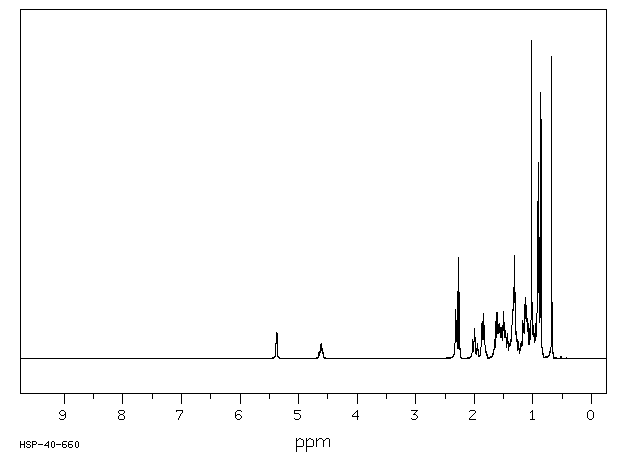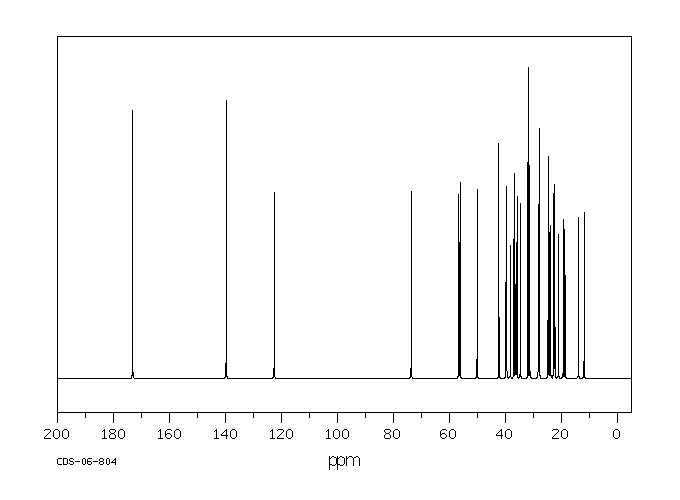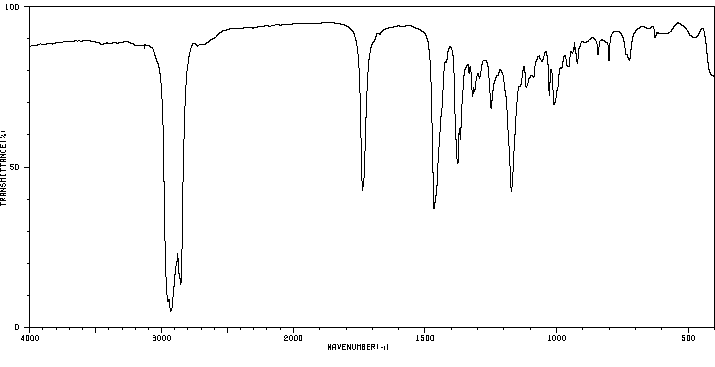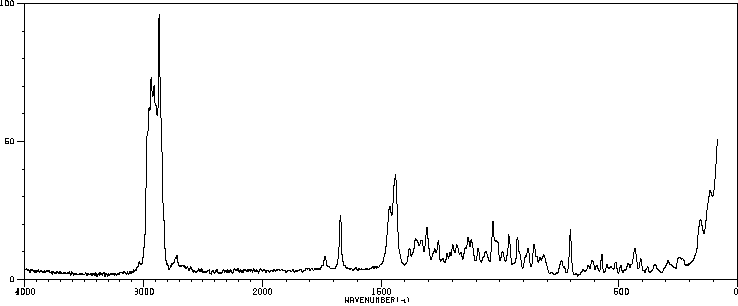胆甾烯基己酸酯 | 1062-96-0
物质功能分类
分子结构分类
中文名称
胆甾烯基己酸酯
中文别名
胆固醇己酸酯;己酸胆固醇酯;胆固醇已酸酯、液晶CHX;液晶CHX;胆固醇己酸盐;胆甾-5-烯-3-醇(3β)己酸酯;胆甾醇己酸酯
英文名称
cholesterol caproate
英文别名
cholesteryl caproate;Cholest-5-en-3beta-yl hexanoate;[(3S,8S,9S,10R,13R,14S,17R)-10,13-dimethyl-17-[(2R)-6-methylheptan-2-yl]-2,3,4,7,8,9,11,12,14,15,16,17-dodecahydro-1H-cyclopenta[a]phenanthren-3-yl] hexanoate
CAS
1062-96-0
化学式
C33H56O2
mdl
MFCD00037707
分子量
484.806
InChiKey
FPBODWXATDKICU-FLFWOSPYSA-N
BEILSTEIN
——
EINECS
——
-
物化性质
-
计算性质
-
ADMET
-
安全信息
-
SDS
-
制备方法与用途
-
上下游信息
-
文献信息
-
表征谱图
-
同类化合物
-
相关功能分类
-
相关结构分类
物化性质
-
熔点:96 °C
-
沸点:541.8±29.0 °C(Predicted)
-
密度:0.98±0.1 g/cm3(Predicted)
-
稳定性/保质期:
常温常压下稳定,避免与氧化物接触。
计算性质
-
辛醇/水分配系数(LogP):11
-
重原子数:35
-
可旋转键数:11
-
环数:4.0
-
sp3杂化的碳原子比例:0.909
-
拓扑面积:26.3
-
氢给体数:0
-
氢受体数:2
安全信息
-
WGK Germany:3
-
储存条件:-20°C密封储存
SDS
己酸胆固醇酯 修改号码:5
模块 1. 化学品
产品名称: Cholesterol Hexanoate
修改号码: 5
模块 2. 危险性概述
GHS分类
物理性危害 未分类
健康危害 未分类
环境危害 未分类
GHS标签元素
图标或危害标志 无
信号词 无信号词
危险描述 无
防范说明 无
模块 3. 成分/组成信息
单一物质/混和物 单一物质
化学名(中文名): 己酸胆固醇酯
百分比: >95.0%(GC)
CAS编码: 1062-96-0
俗名: Hexanoic Acid Cholesterol Ester
分子式: C33H56O2
模块 4. 急救措施
吸入: 将受害者移到新鲜空气处,保持呼吸通畅,休息。若感不适请求医/就诊。
皮肤接触: 立即去除/脱掉所有被污染的衣物。用水清洗皮肤/淋浴。
若皮肤刺激或发生皮疹:求医/就诊。
眼睛接触: 用水小心清洗几分钟。如果方便,易操作,摘除隐形眼镜。继续清洗。
如果眼睛刺激:求医/就诊。
食入: 若感不适,求医/就诊。漱口。
紧急救助者的防护: 救援者需要穿戴个人防护用品,比如橡胶手套和气密性护目镜。
模块 5. 消防措施
合适的灭火剂: 干粉,泡沫,雾状水,二氧化碳
己酸胆固醇酯 修改号码:5
模块 5. 消防措施
特定方法: 从上风处灭火,根据周围环境选择合适的灭火方法。
非相关人员应该撤离至安全地方。
周围一旦着火:如果安全,移去可移动容器。
消防员的特殊防护用具: 灭火时,一定要穿戴个人防护用品。
模块 6. 泄漏应急处理
个人防护措施,防护用具, 使用个人防护用品。远离溢出物/泄露处并处在上风处。
紧急措施: 泄露区应该用安全带等圈起来,控制非相关人员进入。
环保措施: 防止进入下水道。
控制和清洗的方法和材料: 清扫收集粉尘,封入密闭容器。注意切勿分散。附着物或收集物应该立即根据合适的
法律法规处置。
模块 7. 操作处置与储存
处理
技术措施: 在通风良好处进行处理。穿戴合适的防护用具。防止粉尘扩散。处理后彻底清洗双手
和脸。
注意事项: 如果粉尘或浮质产生,使用局部排气。
操作处置注意事项: 避免接触皮肤、眼睛和衣物。
贮存
储存条件: 保持容器密闭。存放于凉爽、阴暗处。
远离不相容的材料比如氧化剂存放。
包装材料: 依据法律。
模块 8. 接触控制和个体防护
工程控制: 尽可能安装封闭体系或局部排风系统,操作人员切勿直接接触。同时安装淋浴器和洗
眼器。
个人防护用品
呼吸系统防护: 防尘面具。依据当地和政府法规。
手部防护: 防护手套。
眼睛防护: 安全防护镜。如果情况需要,佩戴面具。
皮肤和身体防护: 防护服。如果情况需要,穿戴防护靴。
模块 9. 理化特性
固体
外形(20°C):
外观: 晶体-粉末
颜色: 白色-极淡的黄色
气味: 无资料
pH: 无数据资料
熔点:
96°C
沸点/沸程 无资料
闪点: 无资料
爆炸特性
爆炸下限: 无资料
爆炸上限: 无资料
密度: 无资料
溶解度:
[水] 无资料
[其他溶剂] 无资料
己酸胆固醇酯 修改号码:5
模块 10. 稳定性和反应性
化学稳定性: 一般情况下稳定。
危险反应的可能性: 未报道特殊反应性。
须避免接触的物质 氧化剂
危险的分解产物: 一氧化碳, 二氧化碳
模块 11. 毒理学信息
急性毒性: 无资料
对皮肤腐蚀或刺激: 无资料
对眼睛严重损害或刺激: 无资料
生殖细胞变异原性: 无资料
致癌性:
IARC = 无资料
NTP = 无资料
生殖毒性: 无资料
模块 12. 生态学信息
生态毒性:
鱼类: 无资料
甲壳类: 无资料
藻类: 无资料
残留性 / 降解性: 无资料
潜在生物累积 (BCF): 无资料
土壤中移动性
log水分配系数: 无资料
土壤吸收系数 (Koc): 无资料
亨利定律 无资料
constaNT(PaM3/mol):
模块 13. 废弃处置
如果可能,回收处理。请咨询当地管理部门。建议在可燃溶剂中溶解混合,在装有后燃和洗涤装置的化学焚烧炉中
焚烧。废弃处置时请遵守国家、地区和当地的所有法规。
模块 14. 运输信息
联合国分类: 与联合国分类标准不一致
UN编号: 未列明
模块 15. 法规信息
《危险化学品安全管理条例》(2002年1月26日国务院发布,2011年2月16日修订): 针对危险化学品的安全使用、
生产、储存、运输、装卸等方面均作了相应的规定。
己酸胆固醇酯 修改号码:5
模块16 - 其他信息
N/A
模块 1. 化学品
产品名称: Cholesterol Hexanoate
修改号码: 5
模块 2. 危险性概述
GHS分类
物理性危害 未分类
健康危害 未分类
环境危害 未分类
GHS标签元素
图标或危害标志 无
信号词 无信号词
危险描述 无
防范说明 无
模块 3. 成分/组成信息
单一物质/混和物 单一物质
化学名(中文名): 己酸胆固醇酯
百分比: >95.0%(GC)
CAS编码: 1062-96-0
俗名: Hexanoic Acid Cholesterol Ester
分子式: C33H56O2
模块 4. 急救措施
吸入: 将受害者移到新鲜空气处,保持呼吸通畅,休息。若感不适请求医/就诊。
皮肤接触: 立即去除/脱掉所有被污染的衣物。用水清洗皮肤/淋浴。
若皮肤刺激或发生皮疹:求医/就诊。
眼睛接触: 用水小心清洗几分钟。如果方便,易操作,摘除隐形眼镜。继续清洗。
如果眼睛刺激:求医/就诊。
食入: 若感不适,求医/就诊。漱口。
紧急救助者的防护: 救援者需要穿戴个人防护用品,比如橡胶手套和气密性护目镜。
模块 5. 消防措施
合适的灭火剂: 干粉,泡沫,雾状水,二氧化碳
己酸胆固醇酯 修改号码:5
模块 5. 消防措施
特定方法: 从上风处灭火,根据周围环境选择合适的灭火方法。
非相关人员应该撤离至安全地方。
周围一旦着火:如果安全,移去可移动容器。
消防员的特殊防护用具: 灭火时,一定要穿戴个人防护用品。
模块 6. 泄漏应急处理
个人防护措施,防护用具, 使用个人防护用品。远离溢出物/泄露处并处在上风处。
紧急措施: 泄露区应该用安全带等圈起来,控制非相关人员进入。
环保措施: 防止进入下水道。
控制和清洗的方法和材料: 清扫收集粉尘,封入密闭容器。注意切勿分散。附着物或收集物应该立即根据合适的
法律法规处置。
模块 7. 操作处置与储存
处理
技术措施: 在通风良好处进行处理。穿戴合适的防护用具。防止粉尘扩散。处理后彻底清洗双手
和脸。
注意事项: 如果粉尘或浮质产生,使用局部排气。
操作处置注意事项: 避免接触皮肤、眼睛和衣物。
贮存
储存条件: 保持容器密闭。存放于凉爽、阴暗处。
远离不相容的材料比如氧化剂存放。
包装材料: 依据法律。
模块 8. 接触控制和个体防护
工程控制: 尽可能安装封闭体系或局部排风系统,操作人员切勿直接接触。同时安装淋浴器和洗
眼器。
个人防护用品
呼吸系统防护: 防尘面具。依据当地和政府法规。
手部防护: 防护手套。
眼睛防护: 安全防护镜。如果情况需要,佩戴面具。
皮肤和身体防护: 防护服。如果情况需要,穿戴防护靴。
模块 9. 理化特性
固体
外形(20°C):
外观: 晶体-粉末
颜色: 白色-极淡的黄色
气味: 无资料
pH: 无数据资料
熔点:
96°C
沸点/沸程 无资料
闪点: 无资料
爆炸特性
爆炸下限: 无资料
爆炸上限: 无资料
密度: 无资料
溶解度:
[水] 无资料
[其他溶剂] 无资料
己酸胆固醇酯 修改号码:5
模块 10. 稳定性和反应性
化学稳定性: 一般情况下稳定。
危险反应的可能性: 未报道特殊反应性。
须避免接触的物质 氧化剂
危险的分解产物: 一氧化碳, 二氧化碳
模块 11. 毒理学信息
急性毒性: 无资料
对皮肤腐蚀或刺激: 无资料
对眼睛严重损害或刺激: 无资料
生殖细胞变异原性: 无资料
致癌性:
IARC = 无资料
NTP = 无资料
生殖毒性: 无资料
模块 12. 生态学信息
生态毒性:
鱼类: 无资料
甲壳类: 无资料
藻类: 无资料
残留性 / 降解性: 无资料
潜在生物累积 (BCF): 无资料
土壤中移动性
log水分配系数: 无资料
土壤吸收系数 (Koc): 无资料
亨利定律 无资料
constaNT(PaM3/mol):
模块 13. 废弃处置
如果可能,回收处理。请咨询当地管理部门。建议在可燃溶剂中溶解混合,在装有后燃和洗涤装置的化学焚烧炉中
焚烧。废弃处置时请遵守国家、地区和当地的所有法规。
模块 14. 运输信息
联合国分类: 与联合国分类标准不一致
UN编号: 未列明
模块 15. 法规信息
《危险化学品安全管理条例》(2002年1月26日国务院发布,2011年2月16日修订): 针对危险化学品的安全使用、
生产、储存、运输、装卸等方面均作了相应的规定。
己酸胆固醇酯 修改号码:5
模块16 - 其他信息
N/A
上下游信息
-
上游原料
中文名称 英文名称 CAS号 化学式 分子量 胆固醇 cholesterol 57-88-5 C27H46O 386.662
反应信息
-
作为反应物:描述:胆甾烯基己酸酯 在 dioxo(tetramesitylporphyrinato)ruthenium(VI) 氧气 作用下, 以 苯 为溶剂, 反应 96.0h, 以91%的产率得到3β-(hexanoyloxy)-5β,6β-epoxy-5β-cholestane参考文献:名称:A Convenient Synthesis of 5,6β-Epoxides of Some Cholesteryl Esters and Δ5-Ketosteroid Derivatives by Catalytic β-Stereoselective Epoxidation摘要:报道了在四甲基卟啉钌络合物催化剂存在下,空气对一系列胆固醇酯进行环氧化反应的研究。该制备方法仅需加入4至5摩尔%的催化剂,即可实现高转化率(76至94%)和极高β立体选择性(> 99%)。类似的结果也在3β-乙酰氧基雄甾-5-烯-17-酮、3β-乙酰氧基孕甾-5-烯-20-酮和3,3-亚乙二氧基胆甾-5-烯的环氧化反应中获得。DOI:10.1055/s-1989-27261
-
作为产物:描述:参考文献:名称:Swell; Treadwell, Journal of Biological Chemistry, 1955, vol. 212, p. 141,143摘要:DOI:
文献信息
-
Radical Fluorosulfonylation: Accessing Alkenyl Sulfonyl Fluorides from Alkenes作者:Xingliang Nie、Tianxiao Xu、Jinshuai Song、Anandkumar Devaraj、Bolun Zhang、Yong Chen、Saihu LiaoDOI:10.1002/anie.202012229日期:2021.2.19extensive studies on FSO2+‐type reagents, a radical fluorosulfonylation reaction with a fluorosulfonyl radical (FSO2.) remains elusive so far, probably owing to its instability and difficulty in generation. Herein, the development of the first radical fluorosulfonylation of alkenes based on FSO2 radicals generated under photoredox conditions is reported. This radical approach provides a new and general access
-
β-Selective Epoxidation of Cholesterol Derivatives with Molecular Oxygen and Aldehyde Catalyzed by Manganese(II) Complex作者:Tohru Yamada、Kiyomi Imagawa、Teruaki MukaiyamaDOI:10.1246/cl.1992.2109日期:1992.11In the presence of a catalytic amount of bis(dipivaloylmethanato)manganese(II) (= Mn(dpm)2), various cholesterol derivatives are smoothly converted into the corresponding β-epoxides in good to high yields with combined use of molecular oxygen and isobutyraldehyde. These stereoselectivities are the reversal of the cases using peracid such as mCPBA.
-
Aqueous photoprotective compositions comprising acrylamido-2-methylpropanesulfonic acid polymers and 4,4-diarylbutadiene UV-A sunscreens申请人:L'OREAL公开号:US20040228815A1公开(公告)日:2004-11-18Photoprotective compositions, e.g., oil-in-water or water-in-oil emulsions, well suited for the photoprotection of the skin, lips and/or hair against the damaging effects of UV-radiation, comprise at least one aqueous phase, at least one oily phase, at least one partially or completely neutralized, crosslinked or non-crosslinked water-soluble or water-dispersible acrylamido-2-methylpropanesulfonic acid (AMPS) polymer and at least one UV radiation-screening system, said at least one screening system comprising at least one 4,4-diarylbutadiene UV-A-screening agent
-
IONIZABLE COMPOUNDS AND COMPOSITIONS AND USES THEREOF申请人:Nitto Denko Corporation公开号:US20160376229A1公开(公告)日:2016-12-29This invention includes ionizable compounds, and compositions and methods of use thereof. The ionizable compounds can be used for making nanoparticle compositions for use in biopharmaceuticals and therapeutics. More particularly, this invention relates to compounds, compositions and methods for providing nanoparticles to encapsulate active agents, such as nucleic acid agents, and to deliver and distribute the active agents to cells, tissues, organs, and subjects.这项发明涉及可离子化的化合物,以及其组合物和使用方法。这些可离子化的化合物可用于制备纳米粒子组合物,用于生物制药和治疗。更具体地说,这项发明涉及提供纳米粒子以包裹活性剂,如核酸剂,并将活性剂传递和分发到细胞、组织、器官和受试者的化合物、组合物和方法。
-
Aqueous antisun/sunscreen compositions comprising amphiphilic 2-Acrylamidomethylpropanesulfonic acid polymers and water-soluble silicones申请人:L'OREAL公开号:US20040228814A1公开(公告)日:2004-11-18Photoprotective compositions well suited for the photoprotection of the skin, lips and/or hair against the damaging effect of UV-radiation comprise at least one aqueous phase and at least one system for screening out UV-radiation, and which also contain: (a) at least one partially or totally neutralized, crosslinked or non-crosslinked amphiphilic polymer of 2-acrylamidomethylpropanesulfonic acid (AMPS), and (b) at least one water-soluble silicone comprising at least one terminal or pendent monovalent polyoxyalkylene group.
表征谱图
-
氢谱1HNMR
-
质谱MS
-
碳谱13CNMR
-
红外IR
-
拉曼Raman
-
峰位数据
-
峰位匹配
-
表征信息
同类化合物
(5β)-17,20:20,21-双[亚甲基双(氧基)]孕烷-3-酮
(5α)-2′H-雄甾-2-烯并[3,2-c]吡唑-17-酮
(3β,20S)-4,4,20-三甲基-21-[[[三(异丙基)甲硅烷基]氧基]-孕烷-5-烯-3-醇-d6
(25S)-δ7-大发酸
(20R)-孕烯-4-烯-3,17,20-三醇
(11β,17β)-11-[4-({5-[(4,4,5,5,5-五氟戊基)磺酰基]戊基}氧基)苯基]雌二醇-1,3,5(10)-三烯-3,17-二醇
齐墩果酸衍生物1
黄麻属甙
黄芪皂苷III
黄芪皂苷 II
黄芪甲苷 IV
黄芪甲苷
黄肉楠碱
黄果茄甾醇
黄杨醇碱E
黄姜A
黄夹苷B
黄夹苷
黄夹次甙乙
黄夹次甙乙
黄夹次甙丙
黄体酮环20-(乙烯缩醛)
黄体酮杂质EPL
黄体酮杂质1
黄体酮杂质
黄体酮杂质
黄体酮EP杂质M
黄体酮EP杂质G(RRT≈2.53)
黄体酮EP杂质F
黄体酮6-半琥珀酸酯
黄体酮 17alpha-氢过氧化物
黄体酮 11-半琥珀酸酯
黄体酮
麦角甾醇葡萄糖苷
麦角甾醇氢琥珀酸盐
麦角甾烷-6-酮,2,3-环氧-22,23-二羟基-,(2b,3b,5a,22R,23R,24S)-(9CI)
麦角甾烷-3,6,8,15,16-五唑,28-[[2-O-(2,4-二-O-甲基-b-D-吡喃木糖基)-a-L-呋喃阿拉伯糖基]氧代]-,(3b,5a,6a,15b,16b,24x)-(9CI)
麦角甾烷-26-酸,5,6:24,25-二环氧-14,17,22-三羟基-1-羰基-,d-内酯,(5b,6b,14b,17a,22R,24S,25S)-(9CI)
麦角甾-8-烯-3-醇
麦角甾-8,24(28)-二烯-26-酸,7-羟基-4-甲基-3,11-二羰基-,(4a,5a,7b,25S)-
麦角甾-7,22-二烯-3-酮
麦角甾-7,22-二烯-17-醇-3-酮
麦角甾-5,24-二烯-26-酸,3-(b-D-吡喃葡萄糖氧基)-1,22,27-三羟基-,d-内酯,(1a,3b,22R)-
麦角甾-5,22,25-三烯-3-醇
麦角甾-4,6,8(14),22-四烯-3-酮
麦角甾-1,4-二烯-3-酮,7,24-二(乙酰氧基)-17,22-环氧-16,25-二羟基-,(7a,16b,22R)-(9CI)
麦角固醇
麦冬皂苷D
麦冬皂苷D
麦冬皂苷 B











